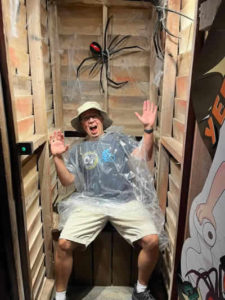Redback Spiders
Latrodectus Hasselti
Distribution:
The Redback is found across all of Australia; commonly found in disturbed and urban regions.
Identification and Habits:
The Redback Spider is black in colour (sometimes they’re brownish) and they have their signature red tripe running down their upper abdomen longitudinally, on the underside of their abdomen there’s also an orange/red spot in the shape of an “hourglass”. The size of the female Redback is roughly the size of a pea and they have slender legs.
The male is tiny, measuring about 3 mm, and are not a risk to anyone. Their webs consist of a tangled, funnel-like upper ‘retreat’ area from which the vertical threads run to the ground, these are particularly stick as they’re purpose is to catch prey. These sticky strands are attached to objects on the ground (they’re built in and around dry and sheltered areas e.g. beneath rocks, in/underneath logs, shrubbery, piles of junk, sheds, privies and so on.) During the winter season this species is less prevalent compared to other seasons.
Bite:
Redback bites are common. Their bite can have serious repercussions and are known to have resulted in deaths. Due to their tiny jaws their bites are often ineffective. Symptoms of a Redback bite are pain (which is commonly very severe), severe sweating (there’s always sweating around the bite as well), also symptoms such as weakness in the muscle where the bite occurred as well as nausea and vomiting. There is anti-venom available and since its introduction there have been no deaths.
First Aid Procedures:
To relieve pain apply an ice pack to the affected area. DON’T apply a pressure bandage due to the fact that the venom’s movement is slow and a pressure bandage would only amplify the pain. For positive and effective identification the spider should be collected. Always seek medical attention
RED BACK SPIDER
Latrodectus hasselti Thorell
[Araneida: Theridiidae]
Article by Bruce Gow
Adult: Redback spiders range from 10-20 mm. The body is round and varies in colour for females, males and juveniles. Females are typically entirely black with a broad red band down the back of the body and a red hourglass mark underneath. Some females, however, are light brown and the typical red markings are orange. Males are white to brown with red markings. Males have black and white banded legs and sometimes white striations from the red stripe down the body. Juveniles are a pale, dirty white with six black spots down the back of the body and a pale hourglass mark underneath. The head is small and has 8 eyes, a pair of fangs and chelicerae. Eyes occur in two rows of four across the front of the carapace in an ellipse. Antennae, wings and cerci are absent in spiders. All 8 legs are similar in shape.
Reproduction& Life-cycle:Adult females lay eggs within a sac. Egg sacs are small, round, white and located on the web. Redback spiders are monovoltine and juveniles overwinter in the egg sac. Adults build an untidy web of fine but strong silk.
Distribution: These spiders are common all over Australia.
Pest Status:Webs are constructed away from the direct effects of weather; under steps, chairs, tables, window sills, under pot plant edges, around rubbish bins and in public buildings and parks, including playground equipment. Redback spiders are fairly timid and only the female is large enough to bite. Bites are toxic and cause intense local pain and local sweating at the site of the bite. In approximately 40% of bites, muscular weakness, paralysis, stiffness, loss of coordination and tremors are common.
“Redbacks are arguably one of the most dangerous spider species in the world. They pose an enormous threat to children as well as adults. Everyone at A1 Pest Control realises how important your family and pets are and we take any pest threat seriously. Call us up today for a hassle free quote or to organise an appointment.”- Bruce Gow
Below: An unfortunate English victim of Red Back Spiders

Contact A1 Pest Control or Bruce today on 0417 251 911
Opening and Closing Hours:
Monday 8am–5pm
Tuesday 8am–5pm
Wednesday 8am–5pm
Thursday 8am–5pm
Friday 8am–5pm
Saturday 10am–2pm
Sunday Closed

